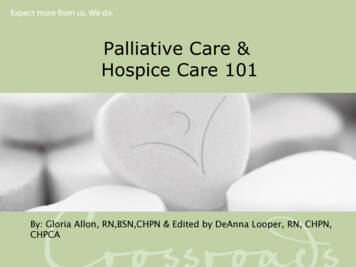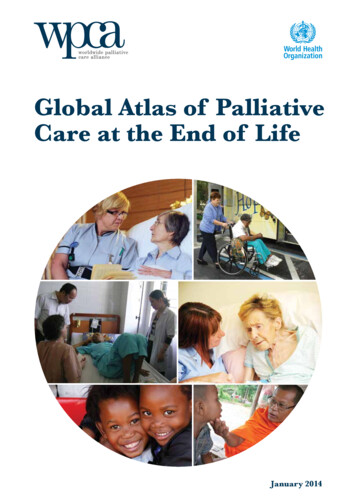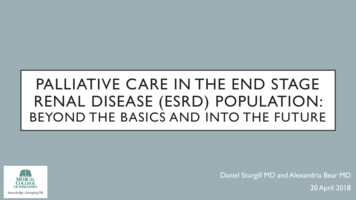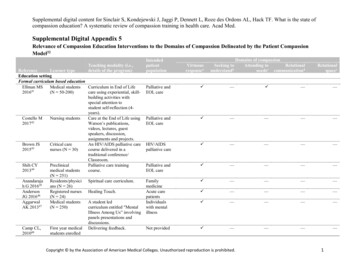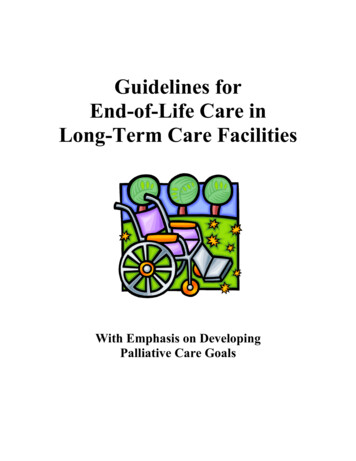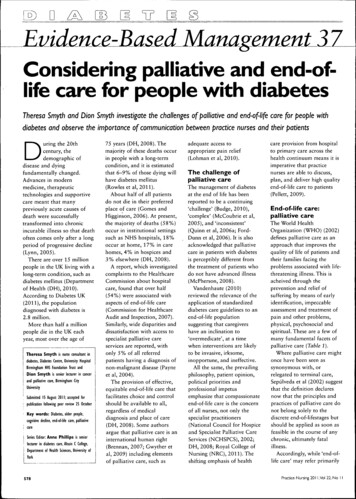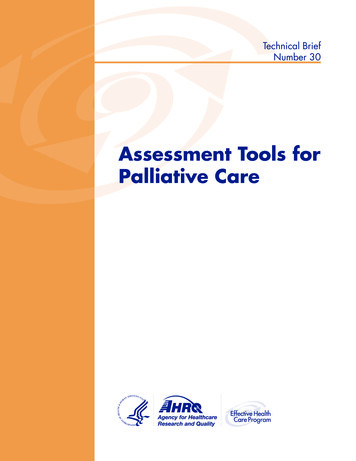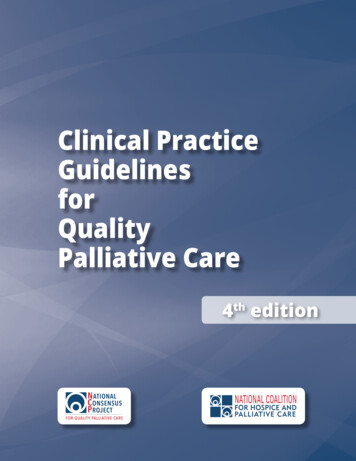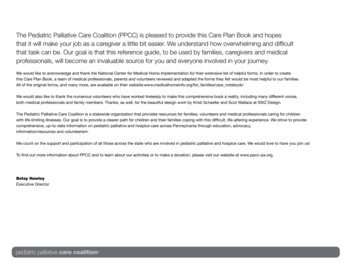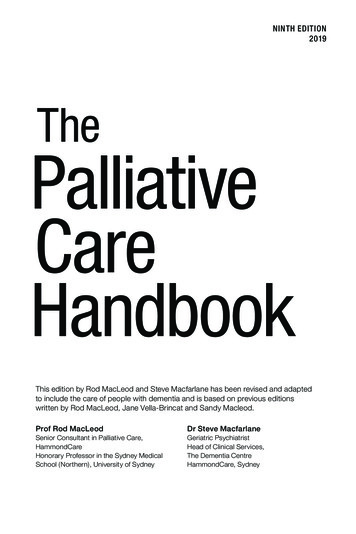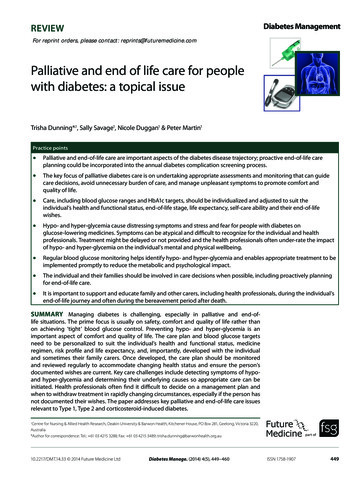
Transcription
Diabetes ManagementREVIEWFor reprint orders, please contact: reprints@futuremedicine.comPalliative and end of life care for peoplewith diabetes: a topical issueTrisha Dunning*,1, Sally Savage1, Nicole Duggan1 & Peter Martin1Practice points Palliative and end-of-life care are important aspects of the diabetes disease trajectory; proactive end-of-life careplanning could be incorporated into the annual diabetes complication screening process. The key focus of palliative diabetes care is on undertaking appropriate assessments and monitoring that can guidecare decisions, avoid unnecessary burden of care, and manage unpleasant symptoms to promote comfort andquality of life. Care, including blood glucose ranges and HbA1c targets, should be individualized and adjusted to suit theindividual’s health and functional status, end-of-life stage, life expectancy, self-care ability and their end-of-lifewishes. Hypo- and hyper-glycemia cause distressing symptoms and stress and fear for people with diabetes onglucose-lowering medicines. Symptoms can be atypical and difficult to recognize for the individual and healthprofessionals. Treatment might be delayed or not provided and the health professionals often under-rate the impactof hypo- and hyper-glycemia on the individual’s mental and physical wellbeing. Regular blood glucose monitoring helps identify hypo- and hyper-glycemia and enables appropriate treatment to beimplemented promptly to reduce the metabolic and psychological impact. The individual and their families should be involved in care decisions when possible, including proactively planningfor end-of-life care. It is important to support and educate family and other carers, including health professionals, during the individual’send-of-life journey and often during the bereavement period after death.SUMMARY Managing diabetes is challenging, especially in palliative and end-oflife situations. The prime focus is usually on safety, comfort and quality of life rather thanon achieving ‘tight’ blood glucose control. Preventing hypo- and hyper-glycemia is animportant aspect of comfort and quality of life. The care plan and blood glucose targetsneed to be personalized to suit the individual’s health and functional status, medicineregimen, risk profile and life expectancy, and, importantly, developed with the individualand sometimes their family carers. Once developed, the care plan should be monitoredand reviewed regularly to accommodate changing health status and ensure the person’sdocumented wishes are current. Key care challenges include detecting symptoms of hypoand hyper-glycemia and determining their underlying causes so appropriate care can beinitiated. Health professionals often find it difficult to decide on a management plan andwhen to withdraw treatment in rapidly changing circumstances, especially if the person hasnot documented their wishes. The paper addresses key palliative and end-of-life care issuesrelevant to Type 1, Type 2 and corticosteroid-induced diabetes.Centre for Nursing & Allied Health Research, Deakin University & Barwon Health, Kitchener House, PO Box 281, Geelong, Victoria 3220,Australia*Author for correspondence: Tel.: 61 03 4215 3288; Fax: 61 03 4215 3489; 33 2014 Future Medicine LtdDiabetes Manage. (2014) 4(5), 449–460part ofISSN 1758-1907449
Review Dunning, Savage, Duggan & MartinKEYWORDS advanced care decisions diabetes end of life guidelines palliative care450Epidemiological research suggests there is astrong association among obesity, diabetes andother obesity-related diseases including someforms of cancer [1] . Diabetes is an increasinglyprevalent disease with a high disease burdendue to complications such as cardiovascular andrenal disease and the associated effects on qualityof life, pain, morbidity and mortality [2] . Thereis also an association between dementia and diabetes [3] and dementia and hypoglycemia [4,5] .There are two main types of diabetes: Type 1(T1DM), which is an autoimmune disease thatresults in destruction of the insulin producing β cells in the pancreas. People with T1DMrequire insulin injections for life to replace theendogenous insulin they cannot produce. Type2 diabetes (T2DM), the most common type, isassociated with insulin resistance, which meansinsulin cannot enter body cells to be utilizedfor energy [6] . People with T2DM often commence treatment with glucose-lowering medicines (GLM) that reduce insulin resistance suchas metformin, especially if they are overweight,but other GLMs are also used. Over time theβ cells become exhausted and no longer produce enough insulin to control blood glucose;consequently insulin is required in the majorityof people with T2DM [7] .Every year 20 million people require palliative care, most in the Western Pacific Region [8] .However, only one in ten people who need orwould benefit from palliative care receive suchcare and 25% of hospital beds are occupied bypeople who are dying [8] . It is not clear whatproportion of these people has diabetes: accurate data about diabetes-related deaths is difficult to obtain because diabetes is not alwayslisted as a contributing cause of death on deathcertificates [9,10] .However, existing information suggests diabetes is a major cause of mortality in older peoplewith diabetes [11] . In addition, diabetes-relatedshort-term complications such as ketoacidosis(DKA) and hyperosmolar states (HHS) are associated with significant discomfort and morbidityand can be life threatening. Chronic hyperglycemia in the longer term increases the risk of cardiovascular disease including heart failure, suddendeath and all-cause mortality among people withT2DM. The mortality risk may be independent of other conventional c a rdiovascular riskfactors [12] .A palliative approach can be integrated withusual diabetes treatment when indicated, forDiabetes Manage. (2014) 4(5)example people on renal dialysis and those withheart failure [13,14] . However, integrated palliative and end-of-life (EoL) care is not included inmost ‘diabetes guidelines’; consequently there islittle guidance to help health professionals planEoL diabetes care. Two exceptions are DiabetesUK 2012 [14] and Dunning et al. 2010 [15] . It isnot clear why EoL care is not included in mostdiabetes guidelines. One reason could be the lackof level one evidence on which to base recommendations. Dunning et al. [15] and presumablyDiabetes UK [14] , regarded the lack of guidanceabout EoL care as a significant care gap thatneeded to be addressed; although the currentauthors are not privy to the UK’s reasons fordeveloping EoL guidelines.Dunning et al. [16] adopted recommendedguideline development processes that includedundertaking a comprehensive literature review toidentify the best available evidence, consultingwith and expert advisory group, regularly meeting with palliative care clinicians to discuss iterative drafts of the guidelines during routine careplanning case discussions. That is, the guidelineswere tested in relevant clinical settings beforethey were released [16] .In addition, Dunning et al. developed a philosophical framework to guide care recommendations and conducted individual interviewswith people with diabetes receiving palliativecare and their family carers about the way theywanted their diabetes managed at the EoL [17] .The guidelines were subjected to public scrutiny before they were released. Future guidelinedevelopers could consider using Dunning et al.’s[16] guideline development method when developing guidelines in situations where there is littleavailable evidence and randomized controlledtrials are not feasible. The recommendations inthis paper are consistent with Dunning et al. [15]and Diabetes UK’s [14] EoL guideline recommendations and encompass Type 1 and 2 diabetesand corticosteroid-induced diabetes.Palliative & end-of-life carePalliative care is defined as an approach thatimproves the quality of life of patients andfamilies living with a life-threatening illness.The focus is on prevention, relieving sufferingby identifying problems early by undertaking athrough assessment and engaging the individualand family carers in care decisions [18] .EoL care refers to care provided to peoplelikely to die in the next 12 months and includesfuture science group
Palliative & end of life care for people with diabetes: a topical issueimminent death (expected in a few hours to days)and progressive incurable diseases, frailty, acutelife-threatening illnesses, and existing diseasesthat can cause sudden death such as diabetes [19] .EoL has been divided into four inter-relatedstages that help guide treatment decisions: stable, unstable, deteriorating and terminal [20] .These stages are not linear, especially in people with diabetes who usually encounter manystable/unstable periods before they begin todeteriorate towards the terminal stage [15] . Forexample, any intercurrent illness or significantlife events usually induce glucose variability andhyperglycemia and its related symptoms and canprogress to ketoacidosis (DKA) and hyperosmolar states (HHS) [21] . DKA and HHS are generally regarded as periods of unstable diabetes thatare usually remediable, including at the EoL.Management dilemmasDiabetes and palliative care health professionals (HP) face many clinical ethical dilemmaswhen managing diabetes in palliative and EoLsituations. In the current paper, clinical ethicaldilemmas refer to situations involving a choicebetween two equally unsatisfactory alternatives[22] . Generally, the situation and the context needto be considered together. The following list represents some clinical ethical dilemmas. Makingdecisions can be especially difficult when theindividual’s wishes are not documented becausethey raise concerns about informed consent andvulnerability [23] : Balancing risk and benefit considering thepathophysiological differences betweenT1DM and 2DM diabetes; Managing corticosteroid-induced hyperglyce-mia and their other effects; Managing nausea, vomiting, anorexia and theassociated consequences such as ineffectivehypoglycemia counter-regulatory response,cachexia, weakness and falls risk; Detecting and managing hypo- and hyper-glycemia, which are life-threatening conditions that compromise comfort and representunstable diabetes that could be remedial; Making appropriate medicine choices; Addressing spiritual needs; Initiating timely discussion about EoL carewith individuals and/or family carers beforecrises occur and making difficult decisionsfuture science groupReviewabout terminal care when the individual’swishes are not documented; Deciding when to withdraw life-sustainingtreatment; that is when it is no longer beneficial and becomes burdensome to the individual/family. Such decisions are more difficultif the individual/family regards treatmentwithdrawal as ‘giving up on them’ and do notrealize the pain and suffering can still betreated [24] .Key management strategiesGenerally, care should be personalized according to the individual’s needs and desires, theirEoL stage, the benefit and risk of any treatmentoptions and life expectancy. Care planningencompasses deciding suitable glycemic targetsto prevent hypo- and hyper-glycemia, managingmedicines and deciding when to stop medicinesand withdraw other treatment [14,15] .Glycemic targetsCardiovascular and renal diseases are leading causes of death in people with diabetes [2] .Maintaining blood glucose and blood pressureclose to the normal ranges helps prevent cardiovascular disease and other diabetes complications when people have a longer life expectancy.Preventing long-term diabetes complications isnot a priority of EoL care.However, managing existing complications topromote comfort and quality of life, relieve painand prevent unnecessary admission to hospital, isimportant, especially during the stable/unstableEoL phases where recovery is likely [2,15,17] .There is no consensus about the optimalHbA1c and blood glucose ranges or the frequencyof blood glucose monitoring (BGM) at the EoL.As indicated, many guideline developers andother diabetes experts agree that these targetsmust to be individualized. Recent blood glucosetarget recommendations are 6–11 mmol/l [15] ,avoiding levels 6 mmol/l and 15 mmol/l [2,14] ,and HbA1c up to 8%. However, there is verylittle evidence to support these recommendations and they most likely do not apply in thedeteriorating and terminal stages. Preventinghyperglycemia in the deteriorating stage is relevant because it exacerbates pain and causesdiscomfort that could be alleviated.Blood glucose monitoringThe value of BGM in T2DM is debated, regardless of the person’s health status. However, BGMwww.futuremedicine.com451
Review Dunning, Savage, Duggan & Martinis important to detect hypo- and hyper-glycemia,which can be difficult at the EoL because symptoms are often atypical and/or attributed to othercauses and not treated. BGM helps detect highand low BG excursions. Our research suggestsmany people with diabetes and their families wantBGM to continue at the EoL because BGM represents stability/familiarity during a frightening,uncertain time and helps them interpret symptoms [15,17] . Some people with diabetes and/or theirfamilies feel abandoned if BGM is discontinuedand may think staff ‘gave up on them.’Research also suggests palliative care staffregard BG monitoring as painful and, unnecessary [25] , which is interesting, consideringother very invasive and painful treatments thatare often used in palliative care. Like all care,BG monitoring frequency should be decidedin consultation with the individual consideringtheir EoL stage, life expectancy, medicine regimen including diabetogenic medicines such ascorticosteroids, and the individual’s hypo- andhyper-glycemia risk profile.HyperglycemiaHyperglycemia is not a benign condition. Itcauses distressing osmotic symptoms such asthirst, urinary frequency and lethargy, exacerbates pain, contributes to delirium and confusion, reduces mood, and affects problemsolving, coping ability and quality of life [17] .Significantly, hyperglycemia can be present without significant symptoms; consequently, it can bemissed and go untreated and progress to DKA orHHS, which are life-threatening situations andrequire urgent care. Dying from DKA or HHSis u ncomfortable and unnecessary.As indicated, people with T1DM require insulin and T2DM is associated with progressive lossof β-cell function and declining insulin production: 50% people with T2DM eventually needinsulin [7] . The need for insulin may be greaterin palliative and EoL care when diabetogenicmedicines and other factors such as pain contribute to hyperglycemia. Managing hyperglycemiaenhances comfort and might include more frequent BG testing, fluid replacement and insulin.Ketone testing should be part of the care plan forT1DM and very ill people with T2DM.Families/carers may need support, frequentexplanations and education about how to recognize and manage hyperglycemia and what BGlevels and symptoms should trigger them to seekhealth professional advice [17] .452Diabetes Manage. (2014) 4(5) HypoglycemiaHypoglycemia is a significant issue risk formany people, see Box 1. It is important to realizethat hypoglycemic risk can change and needsto be assessed regularly. Hypoglycemia affectsdelayed and working memory in the short termand affects decision-making and problem solving [5,26] and can trigger myocardial infarction[24] . In the longer term it is associated withdementia [27] .As indicated, regular BGM is important todetect hypoglycemia in people at high risk ofhypoglycemia. Symptoms can differ from ‘textbook’ symptoms, especially in older peopleand those with long-standing diabetes whenneuro g lycopenic symptoms usually predominate because of the changed counter-regulatoryresponse to falling BG levels. Over time, glucagon,cortisol and growth hormone production diminishes [5,29] . It is important that health professionalslearn to recognize the neuroglycopenic signs andhelp people with diabetes and their f amilies learnto recognize other relevant body cues.Treating hypoglycemia is difficult whenpeople have anorexia and nausea and/or vomiting because of the low glucose stores in muscleand liver and the changed counter-regulatoryresponse to the falling blood glucose level [30,31] .GLMs are often stopped in people who have frequent severe hypoglycemic episodes. However,stopping GLMs might not be appropriate, exceptin the deteriorating and terminal stages becauseof the likelihood of hyperglycemia and its adverseeffects, especially people with T1DM and insulin-requiring T2DM.It is essential to undertake a comprehensivemedicine review and identify and manage otherhypoglycemia risk factors. The choice of GLM/s,dose and dose frequency needs to be carefullyconsidered to maintain BG 6 mmol/l to reducethe hypoglycemia risk [2,14,15] . Educating the individual and family/carers and sometimes healthprofessionals about how to recognize hypoglycemia and any changes to the medicine regimenmight be required.Dietetic advice can help health professionalsand family/carers plan an acceptable diet andprovide supplements if necessary to minimize theeffects of malnutrition, and minimize weight lossand it consequences; loss of muscle mass in thestable and unstable EoL stages. Reversible causesof anorexia and weight loss such as dysphagia,depression, nausea and malabsorption need tobe addressed [32] .future science group
Palliative & end of life care for people with diabetes: a topical issueReviewBox 1. Common risk factors for hypoglycemia in people with diabetes on palliative care and atthe end of life. The more risk factors present the greater the risk of hypoglycemia. Prescribed GLM especially sulphonylureas and insulin Using medicines that interact with GLMs including some herbal GLMs Prescribed medicines that affect appetite Weight loss, malnourishment and cachexia, which affects glucose stores and the ability to mount acounter-regulatory response and which occurs in 40–90% of the cancer palliative care population [5] Renal disease, which is a common complication of diabetes and affects medicine excretion and mayrequire dialysis. End-stage renal disease is an indicator for palliative end-of-life care. Macroalbuminuriapredicts hypoglycemia [28] Liver disease, which affect medicine metabolism Hypoglycemia unawareness, which is common in older people and those with Type 1 diabetes melliusdue to autonomic neuropathy and inability to mount a suitable counter-regulatory response due todeficient secretion of key counter regulatory hormones such as glucagon [5,26]. Severe hypoglycemiais a cause of hospital admission in people 80 years with Type 2 diabetes mellius [19] Cognitive impairment and delirium, which could be from chronic hypoglycemia, hyperglycemia,medicines or dementia Unmanaged pain, which affects appetite. Adequate pain management is essential and is generallywell documented in palliative care plans Fasting for procedures or surgical interventions Health professionals and family carers mistakenly attributing hypo- or hyper-glycemic coma to othercauses, such as the dying processGLM: Glucose-lowering medicine.However, the metabolic processes involved inwasting due to cachexia and sarcopenia that arisein palliative care situations are complex, varyamong different disease processes, and differfrom cancer-related cachexia and are generallyirreversible in advanced disease [32] . Cachexiaand sarcopenia also affect muscle glucose storesand reduce the individual’s capacity to mount acounter-regulatory response to hypoglycemia.Medicine managementQuality use of medicines [33] is essential toachieve acceptable glycemic control and minimize hypoglycemia and other medicine-relatedrisks. QUM encompasses deciding whethera medicine is needed; selecting appropriatemedicine/s if a medicine is required, proactively monitoring medicines effectiveness andstopping medicines (deprescribing) where possible [33,34] . Medicine choices are influenced bytheir availability and cost, the person’s prognosis,health status, oral intake, medicine risk profile,comorbidities and the type of diabetes: T1DMor T2DM.Type 1 diabetesPeople with T1DM in the stable phase couldcontinue their usual insulin regimen. The dosemight need to be adjusted when the persondevelops renal and liver disease, to accommodatefuture science groupweight loss and food intake to avoid hypo- andhyper-glycemia. Medicines are usually ceasedin the terminal stage. Most people with T1DMuse basal (long/intermediate acting)/bolus (rapidacting) insulin regimens. Insulin analogs areoften used. Basal bolus regimens enable insulindoses to be adjusted to accommodate people’seating pattern (give a bolus dose when they eat)and can be particularly useful in the unstableand deteriorating stages and when nausea, vomiting and anorexia are present and to preventhyperglycemia.Specific management in the unstable stagedepends on whether the individual is likely toreturn to stable state or deteriorate and progressto the terminal stage. If recovery is likely, anintravenous insulin infusion might be indicatedduring acute illnesses and surgical procedures.Blood ketone tests should be performed if theblood glucose is 15 mmol/l, especially if theindividual has nausea, vomiting and signs ofdehydration, which could indicate remediableketoacidosis [2,15] .Insulin pumps are increasingly popular, especially among young people with T1DM. Pumpsdeliver a constant small basal dose of insulin andbolus doses when indicated, for example, withmeals, which enables flexible insulin dosing inchanging situations such as palliative and EoLcare [14] . It is essential that HPs understand thatwww.futuremedicine.com453
Review Dunning, Savage, Duggan & Martininsulin pumps only supply rapid-acting insulin:if the pump is turned off or malfunctions theBG can rise very quickly.Generally people who use insulin pumps arevery knowledgeable about and competent tomanage their pumps, but may need help duringperiods of instability. HPs must have the technical expertise and competence to manage insulinpumps and seek expert advice early when suchknowledge is lacking.Type 2 diabetesThe individual’s usual GLM regimen canusually be continued in the stable phase butdoses may need to be reduced or insulin initiated to simplify the medicine regimen and/orreduce the risk of hypoglycemia, especially inthe unstable and deteriorating EoL stages. Thechoice of GLM or GLM combinations shouldsuit the individual’s health status, BG pattern,life expectancy, self-care capacity and hypoglycemia and medicine adverse event risk profile.Gastrointestinal problems such as autonomicneuropathy and malabsorption syndromes caninhibit absorption of oral GLMs and gastrointestinal prokinetic medicines and reducetheir effectiveness [28] . Gastrointestinal stasiscan also delay glucose absorption, which prolongs hypoglycemia [28] . Approximately 75%of people with diabetes have gastrointestinalproblems.Most people with diabetes are prescribed arange of other medicines such as antihypertensive and lipid lowering medicines, anticoagulants for comorbidities and the benefits andrisks of continuing these medicines: the dosesand dose intervals need to be considered with aview to reducing polypharmacy and the medicine burden where possible and safe [35,36] . Theunwanted gastrointestinal effects of nonsteroidal anti-inflammatory medicines need to beconsidered when the individual is anorexic orusing corticosteroids [37] . Table 1 outlines somecommonly used GLMs and relevant issues toconsider before prescribing.Complementary & alternative therapiesComplementary refers to integrating complementary and alternative therapies (CAM) andconventional treatments/medicines; an alternative is used when CAM is used instead ofconventional treatment/medicines [38] .People with diabetes are high CAM users[39,40] . In addition, people receiving palliative454Diabetes Manage. (2014) 4(5)and EoL often use CAM to relieve pain, maintain comfort and quality of life and managethe spiritual aspects of dying to achieve a ‘gooddeath’ [41,42] . CAM is also used to reduce restlessness, agitation and mental stress [43] . Horowitz[43] suggested people receiving palliative or EoLcare often self-prescribe or are prescribed thef ollowing CAM: Massage, with and without essential oils; Music therapy including thanatology; Guided imagery; Essential oils administered in vapourizers,baths or massage; Acupuncture; Pet therapy; the book Making Rounds withOscar [44] demonstrates the power of pets atthe end of life; Meditation; Art therapy; Reflexology.Some herbal medicines can interact with conventional medicines. If herbal medicines are usedthey should be monitored as part of the overallcare plan [45] .Nutrition & hydrationAnorexia, cachexia and dysphagia are common in people receiving palliative care [46] . Inaddition people with diabetes are often deficient in essential nutrients and are often anemic, especially if they have renal disease andare on metformin, which inhibits absorptionof vitamin B12 , thus may require supplementary nutrients including protein in the stableand unstable EoL stages [47] . When people canno longer consume adequate food and fluidsorally, enteral feeds may be required to sustainenergy reserves and provide essential nutritionand fluids.However, the risks and benefits, including therisk of accelerating death, and the individual’sEoL stage must be considered before enteralfeeds are commenced. For example, people inthe stable phase with significant hypoglycemiarisk and renal disease might benefit from extracalories to minimize the hypoglycemia risk.However, enteral feeding may not benefit people with advanced disease where it is unlikelyto improve nutritional or functional status,future science group
Palliative & end of life care for people with diabetes: a topical issueReviewTable 1. Commonly prescribed glucose-lowering medicine classes and some issues to considerwhen prescribing and monitoring glucose-lowering medicines.Medicine classIssues to considerMetforminMetformin is the most commonly used oral GLM especially in overweight people.Renal function needs to be monitored and metformin doses adjusted or themedicine ceased if renal function declines (creatinine 150 mmol/l or eGFR 30 ml/min/1.73 m2). Metformin may also be contraindicated it the person has riskfactors for lactic acidosis, distressing gastrointestinal symptoms such as nausea andflatulence and significant weight lossSulphonylureas may be contraindicated if renal and/or liver disease is present andwhen there is a high risk of hypoglycemiaThiazolididones are not indicated if liver and/or congestive heart failure is present.They cause edema, which can cause discomfort and uncomfortable symptoms.Pioglitazone is contraindicated in people at risk of bladder cancer and people whoalready have bladder cancerGLP-1 and DPP-4 analogs may be an alternative depending on prescribingindications in the relevant country. GLP-1 and sulphonylurea combination increasesthe risk of hypoglycemia. GLP-1 often cause nausea and weight loss and may becontraindicated. Both GLP-1 and DPP-4 have been associated with pancreatitis. Thus,they may not be the best choice in people with pancreatic disease and should bestopped if they cause abdominal painThere is not enough clinical experience with the SGLT-2 medicines to recommendtheir use in palliative care situations and they are not approved for use in manycountries. They are associated with urinary tract and genital infections and polyuriaAs indicated, the majority of people with Type 2 diabetes eventually require insulinand may already be on insulin when they commence palliative care. Insulin doses areeasier to adjust than oral GLMs. Initiating insulin can reduce the tablet burden andsimplify the medicine 2InsulinGLM: Glucose-measuring medicine; SGLT-2: Sodium-glucose cotransporter-2 inhibitor.quality of life or survival [48,32] . Risks associatedwith enteral feeding include, nausea, bloatingand diarrhea, which compromise comfort andquality of life [48] .People who are actively dying do not experience hunger due to ketone production thataccompanies starvation; although they mayexperience thirst, but thirst is not quenched byartificial hydration [49] . Mouth care should beprovided to alleviate dry mouth [49] .Diabetogenic medicinesSome medicines affect glucose homeostasisand cause/exacerbate hyperglycemia in peoplewith diagnosed diabetes and predispose people at risk of diabetes to corticosteroid-induceddiabetes [50,51] . The degree of hyperglycemia isproportional to the dose, dose formulation, doseregimen and duration of treatment [14,36] . Shortcourses may not cause hyperglycemia or onlyhave a short-term effect on the blood glucose.Commonly prescribed diabetogenic medicinesinclude antipsychotic medicines, thiazide diuretics and corticosteroids such as dexamethasone orprednisolone. Corticosteroids are indicated infuture science groupconditions such as hematological malignancies,inflammatory diseases, chronic constructive pulmonary disease, allergies, shock and to managesymptoms in palliative care.Screening people for diabetes risk factorsbefore commencing corticosteroids helps identifythe likelihood the individual will develop corticosteroid-induced hyperglycemia. Educatingpeople with diabetes about the effect corticosteroids could have on their BG and an appropriateBG monitoring regimen enables treatment tobe initiated early to reduce the impact of hyperglycemia on comfort, cognitive function andother symptoms. Box 2 outlines some of the proposed mechanisms for the diabetogenic effectsof corticosteroids,In addition, corticosteroids can mask thesigns and symptoms of infections, which cancompound the fact that
and corticosteroid-induced diabetes. Palliative & end-of-life care Palliative care is defined as an approach that : improves the quality of life of patients and families living with a life-threatening illness. The focus is on prevention, relieving sufferingFile Size: 831KB
